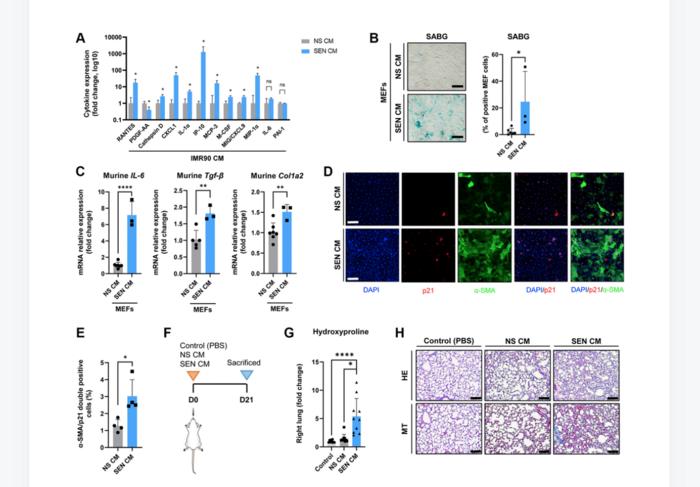“These observations support that accumulation of senescent cells may contribute to fibrotic lung disease […]”

Credit: 2023 Hernandez-Gonzalez et al.
“These observations support that accumulation of senescent cells may contribute to fibrotic lung disease […]”
BUFFALO, NY- July 31, 2023 – A new research paper was published on the cover of Aging (listed by MEDLINE/PubMed as “Aging (Albany NY)” and “Aging-US” by Web of Science) Volume 15, Issue 14, entitled, “Human senescent fibroblasts trigger progressive lung fibrosis in mice.”
Cell senescence has recently emerged as a potentially relevant pathogenic mechanism in fibrosing interstitial lung diseases (f-ILDs), particularly in idiopathic pulmonary fibrosis. In a new study, researchers Fernanda Hernandez-Gonzalez, Neus Prats, Valentina Ramponi, José Alberto López-Domínguez, Kathleen Meyer, Mònica Aguilera, María Isabel Muñoz Martín, Daniel Martínez, Alvar Agusti, Rosa Faner, Jacobo Sellarés, Federico Pietrocola, and Manuel Serrano from Hospital Clinic Barcelona, The Barcelona Institute of Science and Technology (BIST), Instituto de Investigaciones Biomédicas August Pi i Sunyer (IDIBAPS), Centro de Investigación Biomédica en Red Enfermedades Respiratorias (CIBERES), University of Barcelona, Karolinska Institute, Catalan Institution for Research and Advanced Studies (ICREA), and Altos Labs hypothesized that senescent human fibroblasts may suffice to trigger a progressive fibrogenic reaction in the lung.
“Here we: (1) explored this hypothesis in vivo; (2) investigated the potential underlying biological mechanisms in vitro; and (3) studied the effects of one experimental senolytic compound (navitoclax) and two anti-fibrotic drugs currently used in the treatment of IPF in humans (nintedanib and pirfenidone), both in vivo and in vitro.”
To address this, senescent human lung fibroblasts, or their secretome (SASP), were instilled into the lungs of immunodeficient mice. The researchers found that human senescent fibroblasts engraft in the lungs of immunodeficient mice and trigger progressive lung fibrosis associated to increasing levels of mouse senescent cells, whereas non-senescent fibroblasts do not trigger fibrosis. They also found that the SASP of human senescent fibroblasts is pro-senescence and pro-fibrotic both in vitro when added to mouse recipient cells and in vivo when delivered into the lungs of mice, whereas the conditioned medium (CM) from non-senescent fibroblasts lacks these activities. Finally, navitoclax, nintedanib and pirfenidone were found to ameliorate lung fibrosis induced by senescent human fibroblasts in mice, while only navitoclax displayed senolytic activity.
“We conclude that human senescent fibroblasts, through their bioactive secretome, trigger a progressive fibrogenic reaction in the lungs of immunodeficient mice that includes the induction of paracrine senescence in the cells of the host, supporting the concept that senescent cells actively contribute to disease progression in patients with f-ILDs.”
Read the full study: DOI: https://doi.org/10.18632/aging.204825
Corresponding Authors: Manuel Serrano, Federico Pietrocola – [email protected], [email protected]
Keywords: mouse model, cellular senescence, pulmonary fibrosis, antifibrotics, senolytic
Sign up for free Altmetric alerts about this article: https://aging.altmetric.com/details/email_updates?id=10.18632%2Faging.204825
About Aging:
Launched in 2009, Aging (Aging-US) publishes papers of general interest and biological significance in all fields of aging research and age-related diseases, including cancer—and now, with a special focus on COVID-19 vulnerability as an age-dependent syndrome. Topics in Aging go beyond traditional gerontology, including, but not limited to, cellular and molecular biology, human age-related diseases, pathology in model organisms, signal transduction pathways (e.g., p53, sirtuins, and PI-3K/AKT/mTOR, among others), and approaches to modulating these signaling pathways.
Please visit our website at www.Aging-US.com and connect with us:
- SoundCloud
- YouTube
- LabTube
Click here to subscribe to Aging publication updates.
For media inquiries, please contact [email protected].
Aging (Aging-US) Journal Office
6666 E. Quaker Str., Suite 1B
Orchard Park, NY 14127
Phone: 1-800-922-0957, option 1
###
Journal
Aging-US
DOI
10.18632/aging.204825
Method of Research
Experimental study
Subject of Research
Animals
Article Title
Human senescent fibroblasts trigger progressive lung fibrosis in mice
Article Publication Date
1-Jul-2023




